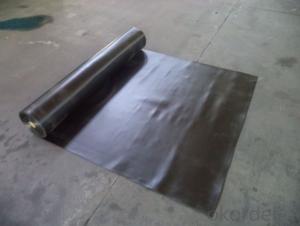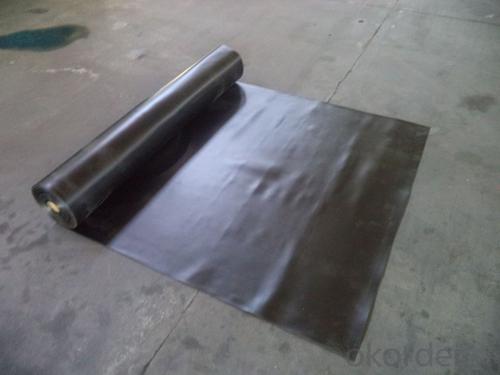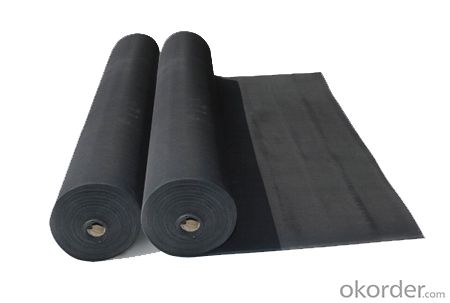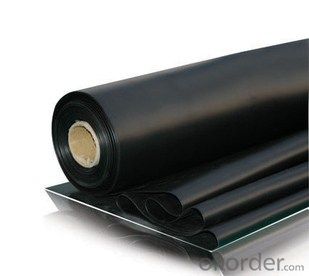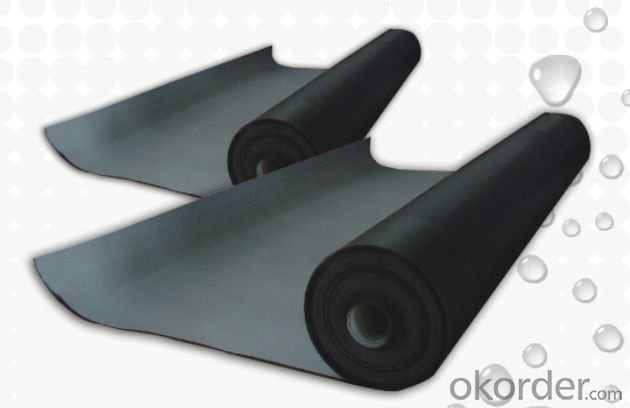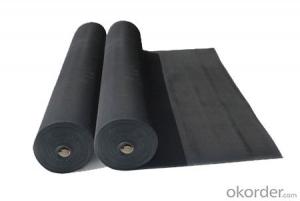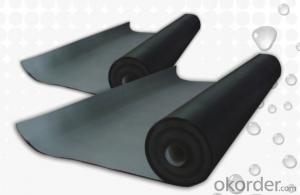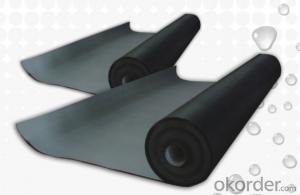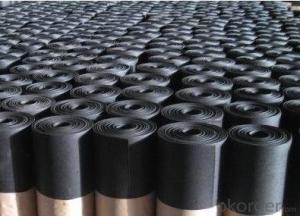EPDM Coiled Waterproof Membrane with 1.8mm Thickness
- Loading Port:
- Shanghai
- Payment Terms:
- TT OR LC
- Min Order Qty:
- 50000 m²
- Supply Capability:
- 5000000 m²/month
OKorder Service Pledge
OKorder Financial Service
You Might Also Like
EPDM Coiled Waterproof Membrane with 1.8mm Thickness
Description Of EPDM Coiled Waterproof Membrane with 1.8mm Thickness:
1. Excellent physical and mechanical performance, high tearing resistance;good deformation adaptability, high puncture resistance;
2. High aging resistance, high UV resistance, anti-acid & alkali;
3. Excellent low & high temperature resistance, innocuous, long life span;
4. Perfect water proof performance, seepage and humidity resistance.
Main Features of EPDM Coiled Waterproof Membrane with 1.8mm Thickness:
A.Polyester based SBS Modified Bitumen Waterproofing Membrane
a. Strong impermeability
b. High tensile strength, elongation, ability to adapt the grassroots shrinkage deformation and cracking
c. Puncture-resistant, broken resistant, tear-resistant
d. The corrosion resistance, resistance to mildew, weathering good
e. Construction convenient, hot-melt can be operated Four Seasons Construction, reliable joints
B. Fiberglass based SBS Modified Bitumen Waterproofing Membrane
a. High tensile strength, stability of a good size
b. High Temperature good performance
c. Damage resistance, corrosion resistance, resistance to mildew, weathering good performance
d. Good construction performance, reliable joints.
Specifications of EPDM Coiled Waterproof Membrane with 1.8mm Thickness:
| Material | EPDM Rubber |
| Size | 1.2m (width)*20m (length) or customized, weldable type 2.05m or 4m width |
| Thick | 1.2mm, 1.5mm, 2.0mm |
| Type | Vulcanized & Weldable |
| Pattern | Non-reinforced (homogeneous) |
| Certificate | ISO9001/14001 |
Applications of EPDM Coiled Waterproof Membrane with 1.8mm Thickness:
geomembrane used in groundsill of road, highway, railway and waterproof layer of swelling clay and wet collapsed loess.Geomembrane can be widely used in areas of garbage burying, waste disposal and underground construction projects.such as below:
- aquaculture ponds
- Ouchi root barrier membrane
- Floating baffles;
- Process wastewater
- Stormwater impoundments;
- Secondary containment;
- Spill containment
- Manure and biogas tanks and covers
- Potable water tanks and covers;
- Sludge Drying beds;
- Bioremediation covers & liners;
- Leachate ponds



IMages of EPDM Coiled Waterproof Membrane with 1.8mm Thickness:




FAQ of EPDM Coiled Waterproof Membrane with 1.8mm Thickness:
1. What are we supplying?
We are specialized in producing Colorful Asphalt Roof Shingle, SBS/APP modified bitumen waterproof membrane, Self adhesive bitumen waterproof membrane, PVC waterproofing membrane, EPDM rubber roofing membrane, Single Component Polyurethane Waterproof Coating, and Spray Polyurea Waterproof Coating
.
2. How Many years experience do we have?
We have been exported to more than 20 countries in the past 15 years.
3. How long do we usually reply your request?
We always reply our customer within 24 hours.
- Q: Can a waterproofing membrane be used on precast stainless steel surfaces?
- Precast stainless steel surfaces can indeed utilize a waterproofing membrane. Regardless of the substrate material, these membranes are specifically designed to form a protective barrier against water infiltration. To effectively safeguard against moisture and avoid any potential harm or leakage, the membrane can be directly applied to the stainless steel surface. However, it is crucial to carefully choose a suitable waterproofing membrane that demonstrates both compatibility with stainless steel and strong adhesion properties. Furthermore, it is imperative to adhere to proper surface preparation and application techniques in order to maximize the membrane's performance.
- Q: Can a waterproofing membrane be applied to horizontal surfaces?
- Horizontal surfaces can indeed have a waterproofing membrane applied to them. In fact, it is quite common to utilize this method in order to safeguard and waterproof flat areas like roofs, decks, balconies, and the like. The membrane functions as a protective barrier, effectively preventing water from infiltrating the surface and causing harm. Typically, this membrane is crafted from a pliable material, such as rubber or modified bitumen, which easily conforms to the contours of the horizontal surface. Moreover, the membrane is specifically engineered to withstand foot traffic and other forms of weight, ensuring long-lasting protection. All in all, the application of a waterproofing membrane to horizontal surfaces proves to be a highly effective means of preventing water damage and prolonging the lifespan of the surface.
- Q: Are there any specific considerations for installing a waterproofing membrane on stucco surfaces?
- Yes, there are specific considerations for installing a waterproofing membrane on stucco surfaces. Firstly, the stucco surface needs to be clean, dry, and free from any loose debris or contaminants. It is important to ensure that the stucco is properly cured before applying the membrane. Additionally, the choice of waterproofing membrane should be compatible with stucco, considering factors such as flexibility, breathability, and adhesion. Proper application techniques, including thorough coverage and proper overlap of the membrane, are crucial to guarantee its effectiveness. It is also advisable to consult with a professional to ensure the correct installation process and product selection for the specific stucco surface.
- Q: Can a waterproofing membrane be used for swimming pool decks and patios?
- Yes, a waterproofing membrane can be used for swimming pool decks and patios. Waterproofing membranes are designed to create a barrier against water infiltration, making them ideal for protecting these outdoor surfaces from water damage and ensuring their longevity.
- Q: Does a waterproofing membrane require a protective layer?
- Yes, a waterproofing membrane typically requires a protective layer. The protective layer serves multiple purposes. Firstly, it helps to prevent damage to the waterproofing membrane during and after installation. It acts as a barrier against sharp objects, construction debris, and potential punctures. Additionally, the protective layer helps to distribute loads evenly and provide stability to the membrane, reducing the risk of damage caused by foot traffic or heavy equipment. Furthermore, the protective layer serves as a UV barrier, shielding the waterproofing membrane from the harmful effects of sunlight exposure. UV rays can degrade the membrane over time, leading to reduced effectiveness and potential leaks. The protective layer also helps to regulate temperature fluctuations, which can expand and contract the membrane, causing stress and compromising its waterproofing capabilities. In summary, a protective layer is essential for the longevity and performance of a waterproofing membrane. It safeguards against physical damage, UV radiation, and temperature fluctuations, ensuring the membrane's effectiveness in keeping water out and preserving the integrity of the structure it protects.
- Q: Can a waterproofing membrane be used for plant rooms and mechanical equipment areas?
- Plant rooms and mechanical equipment areas can benefit from the use of a waterproofing membrane. It is necessary to waterproof these areas in order to safeguard the equipment and surrounding structures against water damage. A waterproofing membrane serves as a commonly implemented solution for this purpose. By forming a barrier, it effectively prevents water infiltration into the plant rooms and mechanical equipment areas, thereby ensuring the equipment remains dry and protected. Moreover, this membrane aids in averting moisture-related problems like the growth of mold and mildew, which can be detrimental to both the equipment's functionality and the overall operation of the plant room. Ultimately, incorporating a waterproofing membrane in plant rooms and mechanical equipment areas proves to be a dependable and efficacious approach for maintaining the longevity and performance of the equipment and structures.
- Q: Can a waterproofing membrane be used for plant rooms or mechanical spaces?
- Yes, a waterproofing membrane can be used for plant rooms or mechanical spaces. These areas often require protection against water damage due to the presence of pipes, equipment, or other mechanical systems. A waterproofing membrane provides an effective barrier to prevent water intrusion and protect the integrity of the space.
- Q: How does a waterproofing membrane handle water infiltration through cracks or gaps?
- By forming a seamless barrier, a waterproofing membrane effectively addresses the issue of water infiltration through cracks or gaps. Typically constructed from durable and flexible materials like rubber, PVC, or modified bitumen, the membrane possesses the ability to withstand the movement and expansion of the underlying structure. When encountering a crack or gap on the surface, the membrane acts as a seal, halting the water from progressing further. The material utilized in the membrane is impervious to water, signifying that it does not permit water molecules to permeate its surface. Furthermore, the membrane is installed in a manner that encompasses the entire surface area, including any existing cracks or gaps. This guarantees the absence of vulnerable points in the waterproofing system, preventing water infiltration. Additionally, the membrane is designed to possess flexibility. This adaptability enables it to accommodate any movement or shifting of the underlying structure without compromising its ability to repel water. This quality proves particularly crucial in areas where cracks or gaps may emerge as a result of natural settling or movement of the building. All in all, a waterproofing membrane capably manages water infiltration through cracks or gaps by providing an uninterrupted, impenetrable barrier that obstructs water from penetrating the structure. It represents a dependable solution for safeguarding buildings and structures from water damage and preserving their integrity over time.
- Q: Can a waterproofing membrane be used for railways or train stations?
- Yes, a waterproofing membrane can be used for railways or train stations. Waterproofing membranes are commonly used in infrastructure projects to prevent water infiltration and protect structures from moisture damage. In railway or train station settings, they can be applied to various areas such as tunnels, platforms, or underground structures to ensure long-term durability and prevent water-related issues.
- Q: How to distinguish whether the waterproofing membrane is polyester tires?
- The easiest way is: hand tear, because the polyester tire than the composite tire body more flexible, so the direct way is to tear the hand is "composite tire", on the contrary is the "polyester tire"
Send your message to us
EPDM Coiled Waterproof Membrane with 1.8mm Thickness
- Loading Port:
- Shanghai
- Payment Terms:
- TT OR LC
- Min Order Qty:
- 50000 m²
- Supply Capability:
- 5000000 m²/month
OKorder Service Pledge
OKorder Financial Service
Similar products
Hot products
Hot Searches
Related keywords
